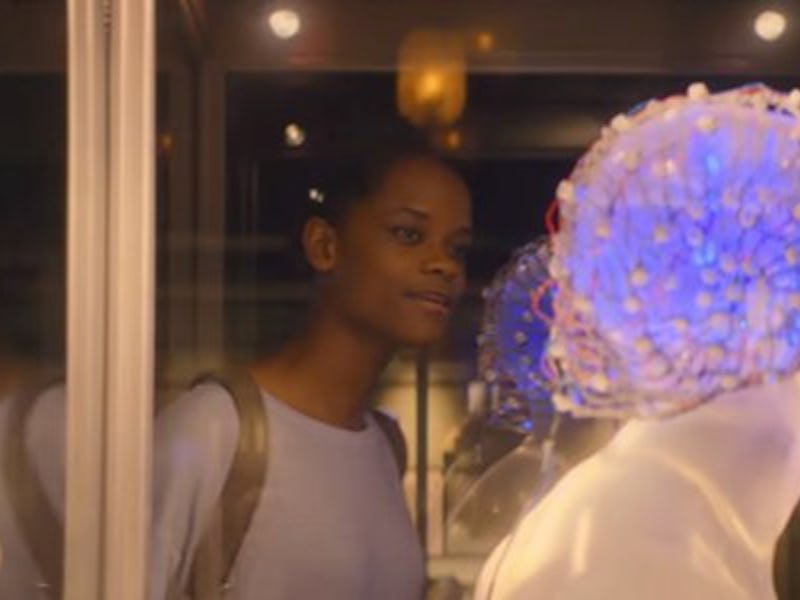"Black Museum" Is the 'Black Mirror' Christmas Special, Except Happy
That's a good thing.

With the release of Season 4 on Netflix, there’s now almost twice as many “American” episodes of Black Mirror as there are “British” ones. Even so, there’s still concern that the Netflix episodes are softer and lighter than episodes showrunner Charlie Booker made for Channel 4. Last season’s “San Junipero” should’ve been enough to convince doubters that Black Mirror could be great without being completely and morbidly nihilistic, but Black Museum makes that case much more explicitly. That’s because the new episode is remarkably similar to an old Black Mirror episode, only it has a happy ending, of sorts.
Also, it’s pretty good.
This post contains spoilers for the Black Mirror Season 4 episode “Black Museum.”
Even down to the name, “Black Museum” is reminiscent of 2014’s Black Mirror Christmas special, White Christmas. That episode, if you forgot, was a mini-anthology starring Jon Hamm, Rafe Spall, and Game of Thrones’s Oona Chaplin. Ham and Spall’s characters are working at a remote outpost, and they tell each other stories about how they ended up in such a miserable place to pass the time. The three stories all come together, horrifyingly, at the end.
“Black Museum” is also a mini-anthology, featuring three morbid stories that all come together at the end — and it even explicitly uses some of the same fictional Black Mirror technology as we saw in “White Christmas.” Letitia Wright stars as Nish, a visitor to a singular museum owned an operated by Rolo Haynes (Douglas Hodge). Rolo is a P. T. Barnum-like figure, only instead of a circus, he has a museum full of horrible biotech mistakes and medical, ethical nightmares.
Rolo and Nish.
He gives Nish a tour, showing her a device that allowed a doctor to feel his patients pain in order to diagnose them — until he became addicted to pain. Then, in the second segment, he shows he a stuffed animal monkey that has a comatose person’s digital consciousness trapped inside it. This is possibly the most upsetting segment, and it’s very similar to the middle section of “White Christmas,” which featured Chaplin’s character as a copied digital consciousness known as a “cookie” that’s been tortured and forced to exist as a personal assistant, forever.
This “White Christmas” connection gets an explicit shout-out, as Rolo explains that the tech in his museum is “how they wound up with the digital consciousness transfers — what they call ‘cookies’ today.”
“Like, when they upload old people to the cloud?” Nish asks, alluding to the tech in “San Junipero,” though Rolo says that came much later.
“Black Museum’s” Third story also involves a digital consciousness, one that Rolo is torturing and “killing” on a regular basis so that ghoulish visitors to his roadside attraction can have a shot at executing a convicted (if potentially innocent) murderer. It’s also horrible — truly, some of the stuff in “Black Museum” are among the most existentially upsetting concepts Black Mirror’s ever dealt with, even if Hodge’s wry performance as Rolo adds some dark humor to the proceedings.
“White Christmas” was also exceptionally fucked-up, but the two otherwise similar episodes go in different directions at the end. In “White Christmas,” even as Matt (Hamm) triumphantly gets the murder confession he was looking for out of a Cookie-version of Joe (Spall), things get much, much worse. All the plot threads come together as Matt finds that he’s a registered sex offender who has been blocked by literally the entire world, and the time perception on Joe’s Cookie is set so that it feels like 1,000 years pass by every minute for an entire night/virtual eternity of hell.
“Black Museum” brings everything together for a happy ending, or what passes for happy in the world of Black Mirror. Nish is actually the daughter of the person Rolo’s “executing,” and she wants revenge. Using all the technology we saw earlier in the episode, she orchestrates a truly epic bit of revenge, and Rolo deserves it. Nish even brings the stuffed monkey out with her as she drives off on the highway to the tune of “Always Something There to Remind Me,” the Black Museum burning in the background.
Make no mistake, this is a dark hour of television, and even the ending has some troubling, troubling implications. But, it’s fun to watch without feeling like it’s going against the spirit of what Black Mirror should be.
The structurally similar “White Christmas” (which also has a similar plot) is so fucking dark and unrelenting when it ends that a typical viewer might want to take a break from Black Mirror for a little bit. “Black Museum” is still dark, but it ends with just enough pep in its step that you’re probably down to stay fixed to your screen and fire up another episode of Black Mirror.
And, isn’t that what’s really scary, in the end?
Black Mirror Season 4 is now on Netflix.